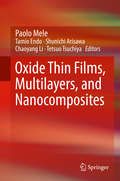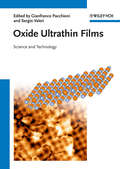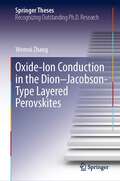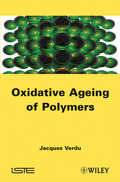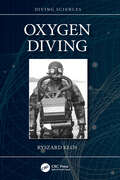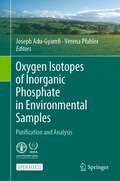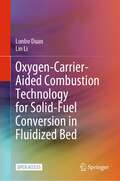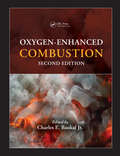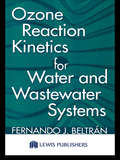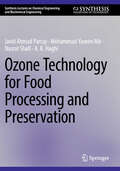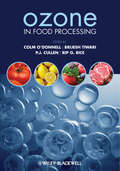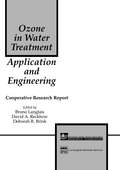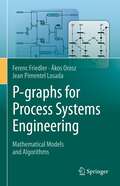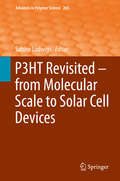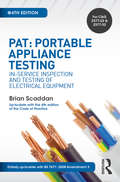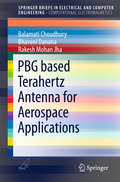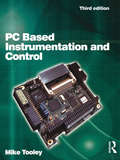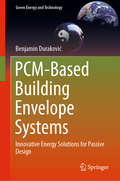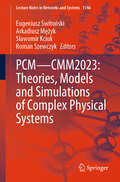- Table View
- List View
Oxide Thin Films, Multilayers, and Nanocomposites
by Paolo Mele Tamio Endo Shunichi Arisawa Chaoyang Li Tetsuo TsuchiyaThis book provides a comprehensive overview of the science of nanostructured oxides. It details the fundamental techniques and methodologies involved in oxides thin film and bulk growth, characterization and device processing, as well as heterostructures. Both, experts in oxide nanostructures and experts in thin film heteroepitaxy, contribute the interactions described within this book.
Oxide Ultrathin Films
by Sergio Valeri Gianfranco PacchioniA wealth of information in one accessible book. Written by international experts from multidisciplinary fields, this in-depth exploration of oxide ultrathin films covers all aspects of these systems, starting with preparation and characterization, and going on to geometrical and electronic structure, as well as applications in current and future systems and devices.From the Contents:Synthesis and Preparation of Oxide Ultrathin FilmsCharacterization Tools of Oxide Ultrathin FilmsOrdered Oxide Nanostructures on Metal SurfacesUnusual Properties of Oxides and Other Insulators in the Ultrathin LimitSilica and High-K Dielectrics Thin Films in MicroelectronicsOxide Passive Films and Corrosion ProtectionOxide Films as Catalytic Materials and as Models of Real CatalystsOxide Films in SpintronicsOxide Ultrathin Films in Solid Oxide Fuel CellsTransparent Conducting and Chromogenic Oxide Films as Solar Energy MaterialsOxide Ultrathin Films in Sensor ApplicationsFerroelectricity in Ultrathin Film CapacitorsTitania Thin Films in Biocompatible Materials and Medical ImplantsOxide Nanowires for New Chemical Sensor Devices
Oxide-Based Materials and Structures: Fundamentals and Applications
by Rada SavkinaOxide-based materials and structures are becoming increasingly important in a wide range of practical fields including microelectronics, photonics, spintronics, power harvesting, and energy storage in addition to having environmental applications. This book provides readers with a review of the latest research and an overview of cutting-edge patents received in the field. It covers a wide range of materials, techniques, and approaches that will be of interest to both established and early-career scientists in nanoscience and nanotechnology, surface and material science, and bioscience and bioengineering in addition to graduate students in these areas. Features: Contains the latest research and developments in this exciting and emerging field Explores both the fundamentals and applications of the research Covers a wide range of materials, techniques, and approaches
Oxide-Ion Conduction in the Dion–Jacobson-Type Layered Perovskites (Springer Theses)
by Wenrui ZhangThis book reports a study of a class of Dion–Jacobson-type layered perovskite oxides in which high oxide-ion conductivities in phases were discovered for the first time in the world. The oxide-ion conductors are important in various energy conversion devices and environmental protection applications such as solid-oxide fuel cells, oxygen gas sensors, oxygen separation membranes, and oxygen-based catalysts. The discoveries are based on a new screening method, called the bond valence method, combined with an original design concept. The present finding of high oxide-ion conductivity reported in the thesis suggested the potential of Dion–Jacobson phases as a platform to identify superior oxide-ion conductors.To understand what causes such high oxide-ion conductivities in these layered perovskite oxides, the author analyzed their crystal structures at high temperature and described the relationship between oxide-ion conductivities and their crystal structures. A deep understanding of the mechanisms of oxide-ion diffusivity at an atomic level in the Dion–Jacobson phases is clarified.The discovery of these materials, the new screening method, and the original design concept make possible the realization of many environment-friendly technologies. The findings in this thesis facilitate the possibilities for many novel applications that will help lead to a sustainable future.
Oxydative Ageing of Polymers
by Jacques VerduThis book aims to rehabilitate kinetic modeling in the domain of polymer ageing, where it has been almost abandoned by the research community. Kinetic modeling is a key step for lifetime prediction, a crucial problem in many industrial domains in which needs cannot be satisfied by the common empirical methods.The book proposes a renewed approach of lifetime prediction in polymer oxidative ageing. This approach is based on kinetic models built from relatively simple mechanistic schemes but integrating physical processes (oxygen diffusion and stabilizer transport), and use property (for instance mechanical failure) changes. An important chapter is dedicated to radiation-induced oxidation and its most important applications: radiochemical ageing at low dose rates and photo-chemical ageing under solar radiation. There is also a chapter devoted to the problem of ageing under coupled oxidation and mechanical loading.
Oxyfuel Combustion for Clean Energy Applications (Green Energy and Technology)
by Hassan M. Badr Medhat A. Nemitallah Mohamed A. HabibThis book aims to be the reference book in the area of oxyfuel combustion, covering the fundamentals, design considerations and current challenges in the field. Its first part provides an overview of the greenhouse gas emission problem and the current carbon capture and sequestration technologies. The second part introduces oxy-fuel combustion technologies with emphasis on system efficiency, combustion and emission characteristics, applications and related challenges. The third part focuses on the recent developments in ion transport membranes and their performance in both oxygen separation units and oxygen transport reactors (OTRs). The fourth part presents novel approaches for clean combustion in gas turbines and boilers. Computational modelling and optimization of combustion in gas turbine combustors and boiler furnaces are presented in the fifth part with some numerical results and detailed analyses.
Oxygen Diving (Diving Sciences)
by Ryszard KlosThe book provides a derivation of the models used for calculating the risk and hazard of central oxygen toxicity pertaining to diving-based studies consistent with the research conducted earlier by the Royal Navy and the US Navy. This book forms the basis for extending the possibility of undertaking nitrox dives in combination with oxygen dives, thus significantly increasing tactical capabilities of conducting diving special operations. Features: provides derivation of the models used for calculating the risk and hazard of central oxygen toxicity improves oxygen diving procedures described in the US Navy Diving Manual includes procedures applicable to undertaking nitrox dives in combination with oxygen dives pitches the material at highest technology readiness levels, i.e. 9 TRL aims to increase tactical capabilities of conducting diving special operations This book is aimed at researchers, professionals and graduate students in life support system design, diving submarine safety, ventilation, health, sanitary engineering, mining engineering and working environment in chambers or closed compartments.
Oxygen Isotopes of Inorganic Phosphate in Environmental Samples: Purification and Analysis
by Joseph Adu-Gyamfi Verena PfahlerThis open access book distinguished itself from other publications by offering step-by-step instructions on how to extract, purify, provide modifications, and major issues to be encountered during the process. For the δ18OP method to progress, further fundamental research as well as field and laboratory studies need to be conducted for a better understanding of P cycling in the environment. Chapter 1 outlines the background and examples of δ18Op studies in sediments, soils, fresh water, mineral fertilizers, and plants. Chapters 2 and 3 examine the stepwise extraction and purification protocols including reagents, equipment and consumables and preparations for analyses. Chapter 4 examines some of the challenges and modifications during the purification process. Chapter 5 discusses planning and designing of a study using δ18Op, external quality assurance with an example of an inter-laboratory study. Chapter 6 outlines the conclusions, future trends, and opportunities, the scaling out of the method from laboratory to field studies. It is expected that the δ18OP would be extensively applied in research geared to understand phosphorus dynamics in different agro-environments.
Oxygen-Carrier-Aided Combustion Technology for Solid-Fuel Conversion in Fluidized Bed
by Lin Li Lunbo DuanThis open access book surveys the development of OCAC technology in the last decade for solid fuel conversion in fluidized beds. The scientific concerns, including combustion and emission characteristics, ash-related problems, OC aging, and so on, are summarized and analyzed. Beyond this, new concepts like OCAC with Oxy-PFBC, OCAC coupled with staged fuel conversion, OCAC in rotatory kilns and multi-functional OCAC are proposed, so as to promote the applications of OCAC to various fields in the future. Moreover, this book also outlines the perspectives for future research and development of OCAC. As an emerging technology, extensive studies and investigations are still necessary to fill in the gap from the fundamental understanding of the technology to its industrial demonstrations. Nevertheless, we believe that this book provides novel insights for the readership of energy and combustion and stimulate meaningful follow-on research on OCAC technology.
Oxygen-Enhanced Combustion
by Charles E. BaukalCombustion technology has traditionally been dominated by air/fuel combustion. However, two developments have increased the significance of oxygen-enhanced combustion-new technologies that produce oxygen less expensively and the increased importance of environmental regulations. Advantages of oxygen-enhanced combustion include less pollutant emissi
Ozarks Conspiracy (Arkansas Special Agents: Cyber Crime Division)
by Maggie WellsShe's become the target of a cybercriminalCan she help him find the culprit? When armed officers burst through the door, Hannah Miller has to prove that her flower shop isn&’t a front for a high-tech bootleg operation. Cybercrime special agent Simon Taylor believes the local business owner is more valuable as an ally. Until the investigation thrusts Hannah into the sights of a very dangerous man. The intrepid florist is willing to put herself in harm&’s way to protect her livelihood and her town. But Simon is just as determined to keep Hannah safe…and alive.From Harlequin Intrigue: Seek thrills. Solve crimes. Justice served.Discover more action-packed stories in the Arkansas Special Agents: Cyber Crime Division series. All books are stand-alone with uplifting endings but were published in the following order: Book 1: Shadowing Her StalkerBook 2: Catching a HackerBook 3: Ozarks Conspiracy
Ozone Reaction Kinetics for Water and Wastewater Systems
by Fernando J. BeltranThis text compiles information about ozonation kinetics of compounds for water and wastewater treatment professionals in a single volume. Application of kinetics to the evaluation, design, and implementation of ozone technology is discussed, along with information to determine when to use ozone treatments, and how to design effective systems. The book is divided into seven themes including: classification and studies on the kinetics of ozone direct reactions in water and wastewater; the determination of ozone rate coefficient (or reactivity quantification) in wastewater, according to the COD level, and the effects on biodegradability; and the kinetic modeling of the ozonation of water and wastewaters.
Ozone Technology for Food Processing and Preservation (Synthesis Lectures on Chemical Engineering and Biochemical Engineering)
by Javid Ahmad Parray Mohammad Yaseen Mir A. K. Haghi Nusrat ShafiOzone is a powerful disinfectant with many applications. This book describes the unique advantages of using ozone technology for food decontamination. Food contamination, especially microbial contamination of fresh produce, is a serious concern in many parts of the world. Ozone decontamination can contribute to food safety and quality retention while avoiding the concerns associated with the use of pesticides. The book begins with an introduction about ozone properties and ozone technology followed by a detailed description of applications of ozone for preservation of grain, fruits, and vegetables, as well as meat and seafood. Possible effects on product quality and shelf life are discussed, and potential research directions for the future are also suggested.
Ozone in Food Processing
by P. J. Cullen Rip G. Rice Colm O’Donnell B. K. TiwariThis book is the first to bring together essential information on the application of ozone in food processing, providing an insight into the current state-of-the-art and reviewing established and emerging applications in food processing, preservation and waste management. The chemical and physical properties of ozone are described, along with its microbial inactivation mechanisms. The various methods of ozone production are compared, including their economic and technical aspects. Several chapters are dedicated to the major food processing applications: fruit and vegetables, grains, meat, seafood and food hydrocolloids, and the effects on nutritional and quality parameters will be reviewed throughout. Further chapters examine the role of ozone in water treatment, in food waste treatment and in deactivating pesticide residues. The international regulatory and legislative picture is addressed, as are the health and safety implications of ozone processing and possible future trends.
Ozone in Water Treatment: Application and Engineering
by Bruno Langlais David A. Reckhow Deborah R. BrinkWith the advent of the Safe Drinking Water Act Amendments of 1986, many water utilities are reexamining their water treatment practices. Upcoming new regulations on disinfection and on disinfection by-products, in particular, are the primary driving forces for the big interest in ozone. It appears that ozone, with its strong disinfection capabilities, and apparently lower levels of disinfection by-products (compared to other disinfectants), may be the oxidant/disinfectant of choice. Many utilities currently using chlorine for oxidation may need to switch due to chlorine by-product concerns. Utilities using chloramines may need to use ozone to meet CT requirements. This book, prepared by 35 international experts, includes current technology on the design, operation, and control of the ozone process within a drinking water plant. It combines almost 100 years of European ozone design and operating experience with North American design/operations experience and the North American regulatory and utility operational environment. Topics covered include ozone chemistry, toxicology, design consideration, engineering aspects, design of retrofit systems, and the operation and economics of ozone technology. The book contains a "how to" section on ozone treatability studies, which explains what information can be learned using treatability studies, at what scale (bench, pilot, or demonstration plant), and how this information can be used to design full-scale systems. It also includes valuable tips regarding important operating practices, as well as guidance on retrofits and the unique issues involved with retrofitting the ozone process.With ozone being one of the hottest areas of interest in drinking water, this book will prove essential to all water utilities, design engineers, regulators, and plant managers and supervisors.
P-graphs for Process Systems Engineering: Mathematical Models and Algorithms
by Ferenc Friedler Ákos Orosz Jean Pimentel LosadaThis book discusses the P-graph framework for developing and understanding effective design tools for process systems engineering, and addresses the current state of its theory and applications. The book details the new philosophy of the axioms-based mathematical modelling of processing systems, the basic algorithms, areas of application, future directions, and the proofs of theorems and algorithms. Because of the rigorous foundation of the theory, the framework provides a firm basis for future research in mathematical modelling, optimization, and design of complex engineering systems. The various P-graph applications discussed include process network synthesis, reliability engineering, and systems resilience. The framework opens new avenues for research in complex systems including redundant operations for critical infrastructure, systems sustainability, and modelling tools for disaster engineering. Demonstration software is provided to facilitate the understanding of the theory. The book will be of interest to institutions, companies, and individuals performing research and R&D in process systems engineering.
P3HT Revisited - From Molecular Scale to Solar Cell Devices
by Sabine LudwigsThe series Advances in Polymer Science presents critical reviews of the present and future trends in polymer and biopolymer science. It covers all areas of research in polymer and biopolymer science including chemistry, physical chemistry, physics, material science. The thematic volumes are addressed to scientists, whether at universities or in industry, who wish to keep abreast of the important advances in the covered topics. Advances in Polymer Science enjoys a longstanding tradition and good reputation in its community. Each volume is dedicated to a current topic, and each review critically surveys one aspect of that topic, to place it within the context of the volume. The volumes typically summarize the significant developments of the last 5 to 10 years and discuss them critically, presenting selected examples, explaining and illustrating the important principles, and bringing together many important references of primary literature. On that basis, future research directions in the area can be discussed. Advances in Polymer Science volumes thus are important references for every polymer scientist, as well as for other scientists interested in polymer science - as an introduction to a neighboring field, or as a compilation of detailed information for the specialist. Review articles for the individual volumes are invited by the volume editors. Single contributions can be specially commissioned. Readership: Polymer scientists, or scientists in related fields interested in polymer and biopolymer science, at universities or in industry, graduate students
PAL Driven Organizational Learning: Theory and Practices
by Kris M. Y. Law Kong Bieng ChuahPresenting an innovative concept and approach for organization management, this book serves to document an organization's journey towards the ultimate goal of learning organization. This book also shares the experience on how a OL framework built on established learning theories, could be used effectively, overcoming many of the barriers in a real industrial setting. Utilizing a ready-to-use tool called Project Action Learning (PAL) to analyze real life case studies, the authors introduce a framework that allows teams of people to work and learn over the course of business projects. Equal emphasis is placed on the achievement of pre-set project outcomes and the learning objectives of the participants. In addition, a long term organizational learning strategy is put forward and the necessary supporting infrastructure, in the form of four 'PAL Pillars', is described. The concepts and development of the PAL driven Organizational Learning model are inspired by and grounded in, Western and Eastern business philosophies and case studies which offer important insights into the management of organizations who are keen to develop sustainable business practices.
PAT: In-Service Inspection and Testing of Electrical Equipment
by Brian ScaddanFully up-to-date with the relevant parts of the 17th Edition IET Wiring Regulations: Amendment 3 and the 2012 Code of Practice Provides all the required information on portable appliance testing in a user-friendly manner Expert advice from an engineering training consultant, supported with colour diagrams, examples and tables The Electricity at Work Regulations 1989 requires any electrical system to be constructed, maintained and used in such a manner as to prevent danger. This means that inspection and testing of systems, including portable appliances, is needed in order to determine if maintenance is required. This book explains in clear language what needs to be done and includes expert advice on legislation as well as actual testing. The book contains an appendix providing the electrical fundamentals needed by non-specialists and also has sample questions (with answers) for the C&G 2377 exam. It is also an ideal revision guide for the non-specialist, such as maintenance staff and caretakers who carry out these tasks part-time, alongside their many other duties.
PB&J Hooray!
by Janet Nolan Julia PattonFrom peanut, grape, and wheat seeds to sandwich, PB&J Hooray! is all about how peanut butter and jelly sandwiches are made. The story begins with the kitchen and works backward to the shopping, delivery, production, harvesting, farming, and planting processes! In fun, rhythmic language, readers discover how peanuts become peanut butter, grapes are made into jelly, and wheat turns into bread.
PBG based Terahertz Antenna for Aerospace Applications
by Rakesh Mohan Jha Balamati Choudhury Bhavani DananaThis book focuses on high-gain antennas in the terahertz spectrum and their optimization. The terahertz spectrum is an unallocated EM spectrum, which is being explored for a number of applications, especially to meet increasing demands of high data rates for wireless space communications. Space communication systems using the terahertz spectrum can resolve the problems of limited bandwidth of present wireless communications without radio-frequency interference. This book describes design of such high-gain antennas and their performance enhancement using photonic band gap (PBG) substrates. Further, optimization of antenna models using evolutionary algorithm based computational engine has been included. The optimized high-performance compact antenna may be used for various wireless applications, such as inter-orbital communications and on-vehicle satellite communications.
PBX Security and Forensics
by I. I. AndroulidakisPBX Security and Forensics presents readers with theoretical and practical background for Private Branch Exchanges (PBXs). PBX is privately owned equipment that serve the communication needs of a private or public entity making connections among internal telephones and linking them to other users in the Public Switched Telephone Network (PSTN). Targeted damages and attacks in PBXs can cause significant instability and problems. The author provides examples of these threats and how to prevent against such attacks in the future. Readers will also be shown where to find forensics data and how to conduct relevant analysis.
PC Based Instrumentation and Control
by Mike TooleyPC Based Instrumentation and Control is a guide to implementing computer control, instrumentation and data acquisition using a standard PC and some of the most popular computer languages.Numerous examples of configurations and working circuits, as well as representative software, make this a practical, hands-on guide to implementing PC-based testing and calibration systems and increasing efficiency without compromising quality or reliability. Guidance is given on modifying the circuits and software routines to meet the reader's specific needs.The third edition includes updated coverage of PC hardware and bus systems, a new chapter on virtual instruments and an introduction to programming and software development in a modern 32-bit environment. Additional examples have been included, with source code and executables available for download from the companion website www.key2control.com.
PCM-Based Building Envelope Systems: Innovative Energy Solutions for Passive Design (Green Energy and Technology)
by Benjamin DurakovićPCM Enhanced Building Envelopes presents the latest research in the field of thermal energy storage technologies that can be applied to solar heating and cooling with the aim of shifting and reducing building energy demand. It discusses both practical and technical issues, as well as the advantages of using common phase change materials (PCMs) in buildings as a more efficient, novel solution for passive solar heating/cooling strategies. The book includes qualitative and quantitative descriptions of the science, technology and practices of PCM-based building envelopes, and reflects recent trends by placing emphasis on energy storage solutions within building walls, floors, ceilings, façades, windows, and shading devices. With the aim of assessing buildings’ energy performance, the book provides advanced modeling and simulation tools as a theoretical basis for the analysis of PCM-based building envelopes in terms of heat storage and transfer. This book will be of interest to all those dealing with building energy analysis such as researchers, academics, students and professionals in the fields of mechanical and civil engineering and architectural design
PCM—CMM2023: Theories, Models and Simulations of Complex Physical Systems (Lecture Notes in Networks and Systems #1146)
by Roman Szewczyk Sławomir Kciuk Arkadiusz Mężyk Eugeniusz ŚwitońskiThe idea of organizing the Polish Congress of Mechanics was born in 2005 among members of the Polish Society of Theoretical and Applied Mechanics. The first Congress has been organized in 2007. In 2013, the organization of the Polish Congress of Mechanics was included in the statutory tasks of the Polish Society of Theoretical and Applied Mechanics. Referring to the splendid tradition of Polish Theoretical and Applied Mechanics, the Congress has become one of the most important international scientific conventions representing this domain of science and gathering every 4 years about 500–600 specialists, who deal with the issues of mechanics and mechanical engineering in a broad sense. The organization of the Congress allows for the connection of many scientific communities, researchers, and engineers from various universities, faculties, research centers, and institutions. Such scientific meeting is an excellent place for presentation, discussion, and dissemination of new achievements and ideas relating to the theoretical foundations as well as practical applications of mechanics. The Congress presents the current state-of-the-art research in all disciplines of classical and quantum mechanics, solid and fluid mechanics, computational mechanics, applied mechanics, and physics, as well as structural mechanics and engineering.
